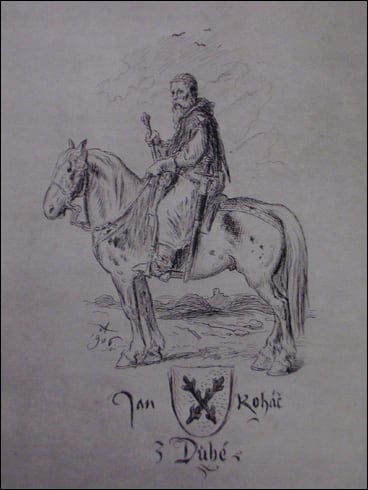Před pár lety jsem tam byl na záchranném výzkumu v oblasti hlavního tábora a jednoho vrhače.
Kušovek bylo mnoho, všechny se zaměřovaly a byla snaha o zjištění směru příletu. A kupodivu
dost šipek nepřilétlo z hradu, ale z druhé strany. Takže někdo musel tábor napadnout ze zálohy. Nicméně asi to tak klidné obléhání nebylo.
Jo a před hradem na poli se našla kompozitní střela, většího průměru, puškaře Zeleného
https://docplayer.cz/33478654-Dobyvani-hradu-sionu-roku-1437-povrchovy-pruzkum-palebnych-postaveni-oblehatelu.html
6.9. 1437 The army captured Jan Rohac of Dubá
Categories: Personalities , Years of war and revolution , Calendar
 Jan Roháč of Dubá belonged to the followers of the radical Hussite movement of the Taborites. In early September 1437 he was captured and executed in Prague on Old Town Square. Of the Gothic castle of Sion, only modest remains of the castle palace and walls have survived.
Jan Roháč of Dubá belonged to the followers of the radical Hussite movement of the Taborites. In early September 1437 he was captured and executed in Prague on Old Town Square. Of the Gothic castle of Sion, only modest remains of the castle palace and walls have survived.
The siege of the castle of Sion lasted until September 1437, despite the fact that Ptacek had a massive conquest slingshot built there. After all, a few thrown boulders or stone balls would have shattered the not very strong wall of Zion like a buckthorn. It was only in autumn that Sigismund ran out of patience and sent a detachment of Michal Orszag, a leading Hungarian grandmaster and also the secret lover of his wife Empress Barbara of Celska, to help the besiegers.
Then everything was quickly decided. "The bird actually had the castle fired upon with a large siege sling and attacked it on September 6, together with Ország's Uhlans. Surprisingly, they surprised the garrison at a peaceful lunch. Zion was quickly conquered and Jan Roháč of Dubá and his friends, the Polish knight Vyšek Račinský, the priest Martin Prostředek, theand other Hussites ended up in captivity," writes Jan Bauer in his book Strange Deaths.
Václav Hájek of Libočany subsequently wrote about the conquest of Sion in his Chronicle of Bohemia: "On the day of the Nativity of the Virgin Mary, before the sun had risen, the conquerors began to come very thickly from the side of theThey fired at the castle from the side and broke a large hole next to one of the bastions in the logs that were on the ramparts. But without delay the besiegers with all diligence made the hole with oak and leafy stumps, and filled it up with earth. One of the dragoons came to the bulwarks and set fire to the splinters, which began to burn very hot, and the fire grew more and more. They saw the siege and extinguished it with great effort, but the wind was from the west and drove the flames into the castle."
Jan Roháč from Dubá, who had just eaten lunch, left his food and helped with the extinguishing. "Then the conquerors approached the ramparts and ran to the fire, and there was a great battle between the conquerors and the besiegedand some of the Roháče were caught off guard by the castle gates, and there they ate it...," wrote Václav Hájek from Libočany.
It was Jan Roháč of Dubá who built the castle of Zion on a rocky promontory between 1426 and 1427. It is located eight kilometres south-west of Kutná Hora. Zion became the last refuge of the radical Hussites against King Sigismund after the Battle of Lipany in 1434. It was conquered after a four-month conquest in 1437.
In fact, there was otherwise no major battle at Sión. The cunning Hynce Ptacek is said to have only faked the siege. Apparently, he only had a siege sling erected in front of Zion, but that was probably all he intended to do to capture his uncle, John Rohace of Dubá. He succeeded, and Roháč was executed in Prague's Old Town Square. Of the Gothic castle of Sion, only modest remains of the castle palace and walls remain.
Sources.
The article is included in categories:
- Archive of articles > Personalities
- Archive of articles > Years of war and revolution
- Archive of articles > Calendar
Post
Jan Roháč nebyl Hynceho strýc, ale pouze vzdálený příbuzný.
Díky za odkaz zubaři.
První z autorů o analýze směru těch šipek mluvil na jiném výzkumu, ale závěr jsem zatím nečetl 





